Fetal electrocardiogram (FECG) extraction has a vital role in medical diagnosis during pregnancy. In this paper, a method for removal of background noise and artifacts from FECG signals using adaptive filters is proposed. The proposed method uses adaptive noise cancellation and digital filters for FECG extraction. Proposed FECG extraction algorithm is implemented in MATLAB using simulink models. Simulation results shows that fetal heart rate can be extracted by counting the peaks of R-R interval from the extracted FECG noise free signal.
Keywords |
| Electrocardiogram, Adaptive Noise Cancellation, Maternal Heart Beat, LMS algorithm |
INTRODUCTION |
| Fetal heart rate (FHR) monitoring is one of the possible solution to test fetal well-being and to diagnose possible
abnormalities. Fetal monitoring during pregnancy stage enables the physician to diagnose and recognize the pathologic
condition especially asphyxia[1]. The electrocardiogram (ECG) is the simplest noninvasive diagnostic method for
various heart diseases. Fetal ECG (FECG) signal reflects the electrical activity of the fetal heart and provides valuable
information of its physiological state. Non-invasive FECG has been used to obtain valuable clinical information about
the fetal condition during pregnancy by using skin electrodes placed on the maternal abdomen[2]. However, abdominal
ECG (AECG) is always corrupted with power line interference, maternal ECG (MECG) and electromyogram (EMG)
where as FECG signal is corrupted by the gestational age, position of the electrodes and the skin impedance.
ECG signal describes the electrical activity of the heart. An ECG signal during a cardiac cycle consists of a P wave,
QRS complex and T wave. The detection of R-peaks i.e., the peaks of the QRS complex in an abdominal
electrocardiogram signal provides information on the heart rate and hence it is an important tool for the physician to
identify abnormalities in the heart activities. ECG signals are commonly measured at two locations: chest and
abdomen[3]. The abdominal leads pick up a composite signal, consisting of the contributions from maternal
electrocardiogram (MECG) and the fetal electrocardiogram (FECG) while the chest leads contains MECG only.
Various research efforts have been proposed to extract the FECG from the AECG such as adaptive filtering, correlation
techniques, blind source separation and a combination of wavelet analysis and blind source separation methods. FHR
can be calculated by determining the R-R intervals from the extracted FECG[4]. However, the extracted FECG is still
corrupted by the residual peaks of MECG (especially its QRS complexes) hence the FECG detection remains difficult.
Rest of the paper is organized as follows. Section II deals with data acquisition and the proposed algorithm for fetal
heart rate extraction is discussed in section III. Simulation results of the proposed method is discussed in Section IV
and finally section V concludes the paper. |
DATA ACQUISITION |
| The shapes of the electrocardiogram signals for both the mother and fetus is simulated assuming that a mother's
heart might produce a 4000 Hz sampling rate. The heart rate for this signal is approximately 89 beats per minute, and
the peak voltage of the signal is 3.5 millivolts.The heart of a fetus beats noticeably faster than that of its mother, with
rates ranging from 20 to 160 beats per minute[5]. The amplitude of the fetal electrocardiogram is also much weaker
than that of the maternal electrocardiogram. The heart rate for the fetal electrocardiogram signal corresponds to 139
beats per minute and a peak voltage of 0.25 millivolts. |
| The measured fetal electrocardiogram signal from the abdomen of the mother is usually dominated by the maternal
heartbeat signal that propagates from the chest cavity to the abdomen. This propagation path can be described as a
linear FIR filter with 10 randomized coefficients. In addition, a small amount of uncorrelated Gaussian noise is added
to simulate any broadband noise sources within the measurement. The maternal electrocardiogram signal is obtained
from the chest of the mother. The goal of the adaptive noise canceller in this task is to adaptively remove the maternal
heartbeat signal from the fetal electrocardiogram signal. The noise canceller needs a reference signal generated from
the maternal electrocardiogram to perform this task. Just like the fetal electrocardiogram signal, the maternal
electrocardiogram signal will contain some additive broadband noise. |
PROPOSED ALGORITHM |
| The block diagram of the proposed algorithm is shown in Fig. 1. |
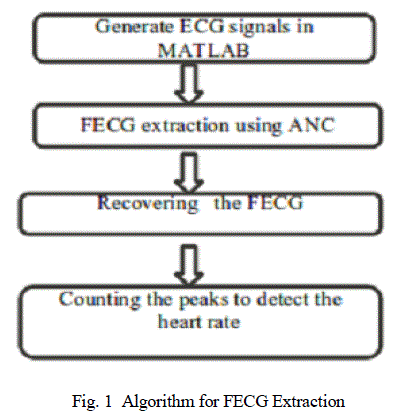 |
| A. Generation of ECG signals in MATLAB |
| MATLAB is used for simulating shapes of the electrocardiogram for both the mother and fetus. Fig. 2 shows the
Maternal ECG signal generated for mothers heart assuming a 4000 Hz sampling rate[6]. The heart rate for this signal is
approximately 89 beats per minute, and the peak voltage of the signal is 3.5 millivolts. The heart of a fetus beats
noticeably faster than that of its mother, with rates ranging from 120 to 160 beats per minute. Fig. 3 shows the FECG
signal generated. The measured fetal electrocardiogram signal from the abdomen of the mother is shown in Fig. 4. It is
usually dominated by the maternal heartbeat signal that propagates from the chest cavity to the abdomen. |
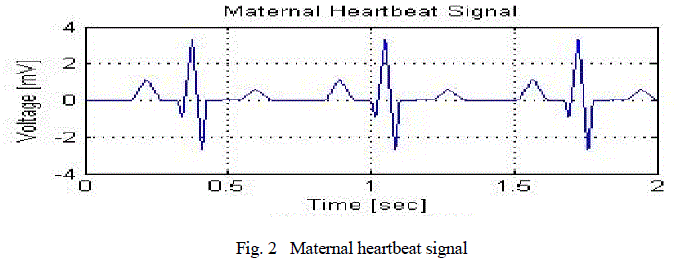 |
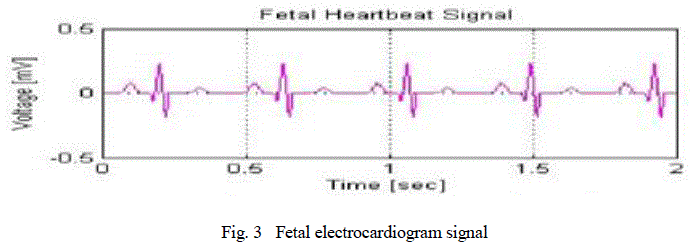 |
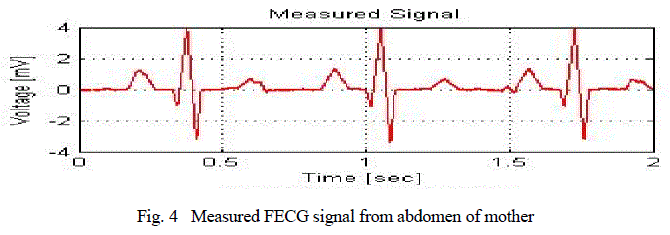 |
| B. FECG Extraction Methods |
| 1) Adaptive noise canceller: Removal of background noise and artifacts from FECG signals using adaptive filters
necessitates the application of two input signals; The primary signal is FECG signal added with MECG signal and the
secondary signal is the reference signal which is the noise to be canceled i.e., MECG signal. The secondary noise signal
must be well-correlated with the noise in the primary signal. Adaptive filters are used in fetal electrocardiography, in
which a maternal heartbeat signal is adaptively removed from a fetal heartbeat signal. |
| An adaptive filter operating in a stationary environment, the error-performance surface has a constant shape as well
as orientation[7]-[10]. When the adaptive filter operates in a non-stationary environment, the bottom of the errorperformance
surface continually moves while the orientation and curvature of the surface may be changing too.
Therefore, when the inputs are non-stationary, the adaptive filter has the task of not only seeking the bottom of the error
performance surface, but also continually tracking it. Fig. 5 shows a basic adaptive noise cancellation system. |
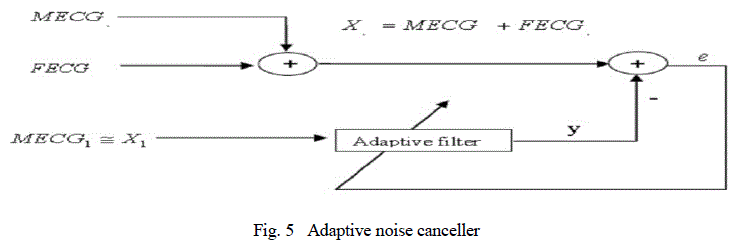 |
| If it is possible to make exact measurements of the gradient vector at each iteration, and if the step-size parameter
is suitably chosen, then the tap-weight vector computed by using the method of steepest-descent would indeed
converge to the optimum Wiener solution[9]. The tap-weight vector is updated in accordance with an algorithm that
adapts to the incoming data. One recursive algorithm for changing tap-weight vector is Least Mean Square (LMS)
algorithm as in (1). Advantage of LMS algorithm is simplicity because it does not require any matrix inversion. |
 |
| 2) Digital filter for high frequency removal: FIR filters are one of two primary types of digital filters used in Digital
Signal Processing (DSP) applications, the other type being IIR. FIR filters can easily be designed to be "linear phase"
without any phase distortion. They are suited to multirate applications like "decimation" (reducing the sampling rate) or
"interpolation" (increasing the sampling rate), or both. Whether decimating or interpolating, the use of FIR filters
allows some of the calculations to be omitted, thus providing an important computational efficiency. In order to fetal
heart rate are the peaks corresponding R wave of the FECG need to be extracted. To achieve this in first stage an FIR
filter is used with appropriate filter coefficients to remove high frequency. The peak corresponding to the R wave of the
FECG are extracted by fixing the threshold value slightly around than the normal level. From the R-R interval the
FETAL heart rate can be obtained. |
RESULTS AND DISCUSSION |
| A. Simulink Model |
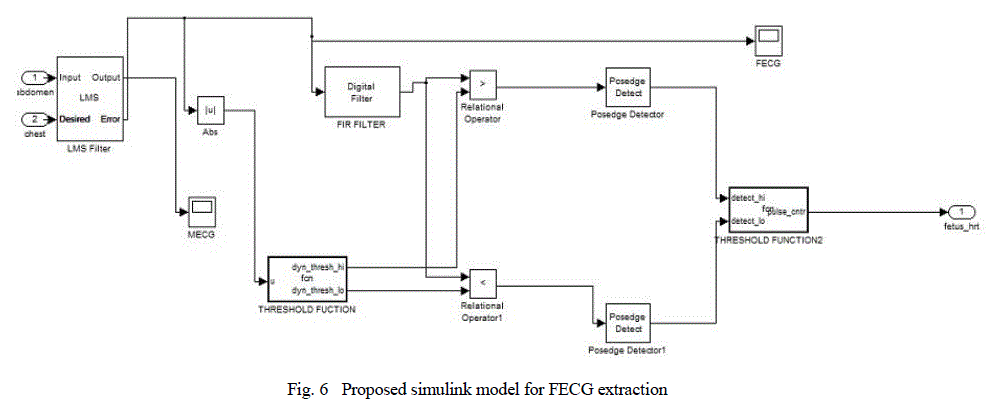 |
| Simulink model is implemented to identify the heart rate of a fetus based on sensor data from two electrodes. There
are two primary signals (mother and baby's heartbeat) with noise superimposed. Fig. 6 shows the proposed simulink
model for FECG extraction. The goal is to filter out everything but the baby's heartbeat and calculate the period of the
signal based on our estimation of that heartbeat. |
| B. Adaptive noise canceller extraction technique |
| The adaptive noise canceller can use almost any adaptive procedure to perform its task. for simplicity, we shall use the
least-mean-square (lms) adaptive filter with 15 coefficients and a step size of 0.00007. With these settings, the adaptive
noise canceller converges reasonably well after a few seconds of adaptation, certainly a reasonable period to wait under
this particular diagnostic application[7]. Fig. 7 shows the measured FECG and Fig. 8. shows the adaptive noise
canceller output. |
 |
| C. Counting the peaks to detect the heart rate |
| The idea is to clean up the signal, and then set some dynamic threshold, so that any signal crossing the threshold is
considered a peak[1]. The peaks can be counted per time window. Fig. 9 shows the peaks that can be counted per time
window and Fig. 10 shows the graph of FECG heart rate. |
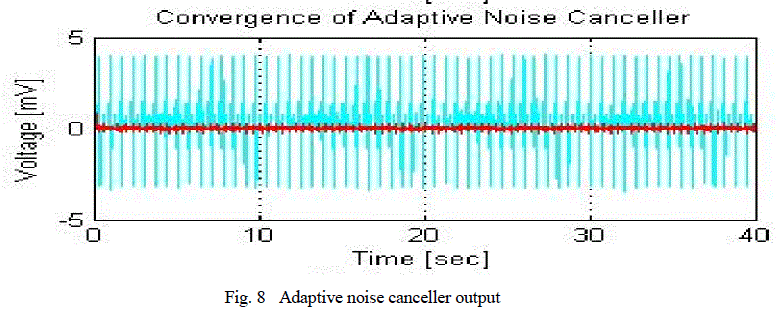 |
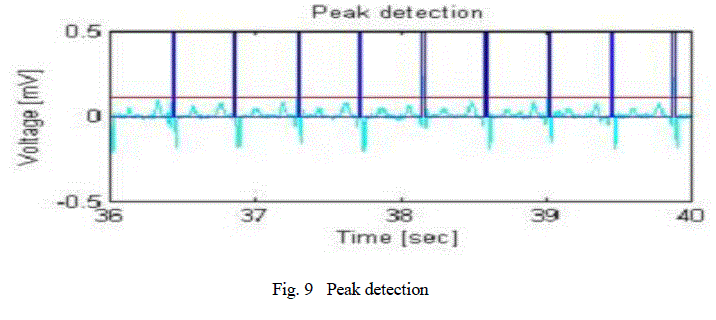 |
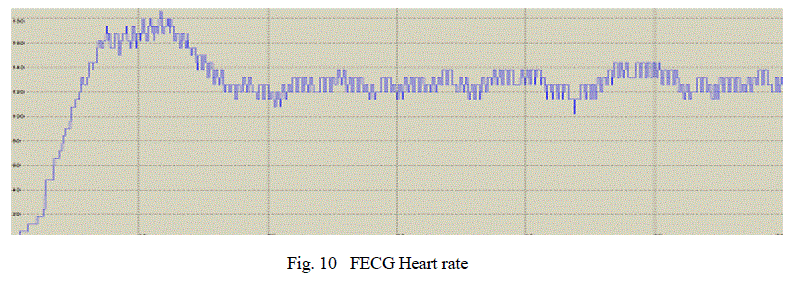 |
CONCLUSION |
| An adaptive noise canceller based fetal electrocardiogram extraction method is proposed and implemented. From
the simulation results we can conclude that FECG signals can be extracted from the abdominal electrocardiogram
signals using LMS algorithm for changing tap-weight vector. Software implementation of LMS algorithm is presented
to implement the ANC system and the proposed algorithm is implemented using simulink. Fetal heart rate signals are
extracted from the peaks of R-R interval. |
References |
- Freeman, R. K., Garite, T. J., Nageotte, M. P., and Miller, L. A., âÃâ¬ÃÅFetal heart rate monitoringâÃâ¬ÃÂ, LWW, 2012.
- Kumar, A., Dewan, L., Singh, M., and Kurukshetra, H., âÃâ¬ÃÅRealtime monitoring system for ECG signal using virtual instrumentationâÃâ¬ÃÂ, IEEE Transactions on Biology and Biomedicine, vol. 3, pp. 638âÃâ¬Ãâ643, 2006.
- Ferrara, E. R., and Widrow, B., âÃâ¬ÃÅFetal electrocardiogram enhancement by time-sequenced adaptive filteringâÃâ¬ÃÂ, IEEE Trans. Biomed. Eng. 29, pp. 458âÃâ¬Ãâ460, 1982.
- Peters, M., Crowe, J., Pieri, J. F., Quartero H., Hayes-Gill, B., James, D., Stinstra, J., and Shakespeare, S., âÃâ¬ÃÅMonitoring the fetal heart noninvasively: a review of methodsâÃâ¬ÃÂ, Journal of perinatal medicine, vol. 29, no. 5, pp. 408âÃâ¬Ãâ416, 2001.
- Ananthanag, K., and Sahambi, L., âÃâ¬ÃÅInvestigation of blind source separation methods for extraction of fetal ECGâÃâ¬ÃÂ, In Canadian Conference on Electrical and Computer Engineering. May 2003.
- Jafari, M. G., and Chambers, J. A., âÃâ¬ÃÅFetal electrocardiogram extraction by sequential source separation in the wavelet domainâÃâ¬ÃÂ, IEEE Transactions on Biomedical Engineering, vol. 52, no. 3, pp.390âÃâ¬Ãâ400, 2005.
- Haykin, S., âÃâ¬ÃÅAdaptive Filter TheoryâÃâ¬ÃÂ, 3rd Edition, Prentice Hall 2002 .
- Widrow, B., âÃâ¬ÃÅAdaptive Noise Cancelling: Principles and ApplicationsâÃâ¬ÃÂ, Proc. IEEE, vol. 63, pp.1692-1716, Dec. 1975.
- John, R. G. Jr., âÃâ¬ÃÅAdaptive Noise Canceling Applied to Sinusoidal InterferencesâÃâ¬ÃÂ, IEEE Trans. ASSP, Vol. ASSP-25, no. 6, pp. 484-491, Dec.1977
- ShikRyu, B., and Lee, J. K., âÃâ¬ÃÅThe Performance of an adaptive noise canceller with DSP processorâÃâ¬ÃÂ, 40th Southeastern Symposium on System Theroy, New Orleans,USA, March 16-18, pp 42-45, 2008.
|